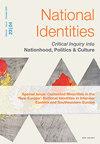巴纳特地区的德意志化:从二元论的匈牙利到两次世界大战之间的罗马尼亚,斯瓦本人的“少数民族形成”
IF 0.7
Q3 POLITICAL SCIENCE
引用次数: 0
摘要
本文考察了巴纳特·斯瓦本人(一个讲德语的少数民族社区)在长期动荡中关于德国性的主导话语的形成。特别是在第一次世界大战之后,关于德国的意义的辩论作为一种政治争论的手段和动员斯瓦比亚社区对抗-à-vis罗马尼亚国家的一种方式变得重要起来。虽然在更广泛的德国民族中归属的呼吁得到了普及,但为传达这种联系而开发的符号显示了对巴纳特·斯瓦本德国的特定地方和区域理解——这一趋势直到20世纪30年代才开始改变,因为这些符号被新的挑战者占用。本文章由计算机程序翻译,如有差异,请以英文原文为准。
Formulating Germanness in the Banat: ‘Minority making’ among the Swabians from Dualist Hungary to interwar Romania
ABSTRACT This article examines the shaping of a dominant discourse on Germanness among the Banat Swabians, a German-speaking minority community, over a long period of upheaval. Particularly following WWI, debates over what it meant to be German gained significance as a means of political contestation and a way of mobilizing the Swabian community vis-à-vis the Romanian state. While appeals to belonging within a broader German nation were popularized, the symbols developed to convey this affiliation showed particular local and regional understandings of Banat Swabian Germanness—a trend that only began to change in the 1930s, as these symbols were appropriated by new challengers.
求助全文
通过发布文献求助,成功后即可免费获取论文全文。
去求助
来源期刊

NATIONAL IDENTITIES
POLITICAL SCIENCE-
CiteScore
1.70
自引率
0.00%
发文量
37
期刊介绍:
National Identities explores the formation and expression of national identity from antiquity to the present day. It examines the role in forging identity of cultural (language, architecture, music, gender, religion, the media, sport, encounters with "the other" etc.) and political (state forms, wars, boundaries) factors, by examining how these have been shaped and changed over time. The historical significance of "nation"in political and cultural terms is considered in relationship to other important and in some cases countervailing forms of identity such as religion, region, tribe or class. The focus is on identity, rather than on contingent political forms that may express it. The journal is not prescriptive or proscriptive in its approach.
 求助内容:
求助内容: 应助结果提醒方式:
应助结果提醒方式:


